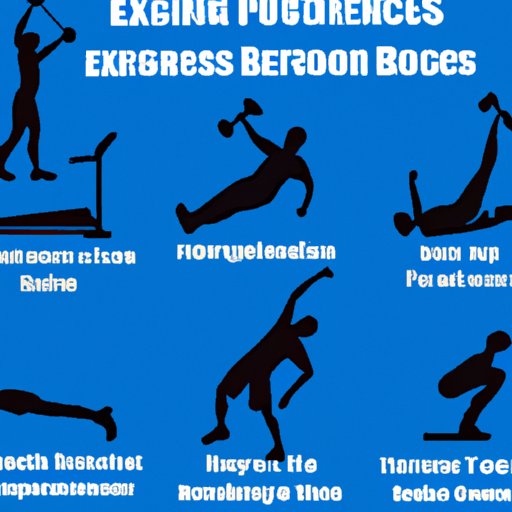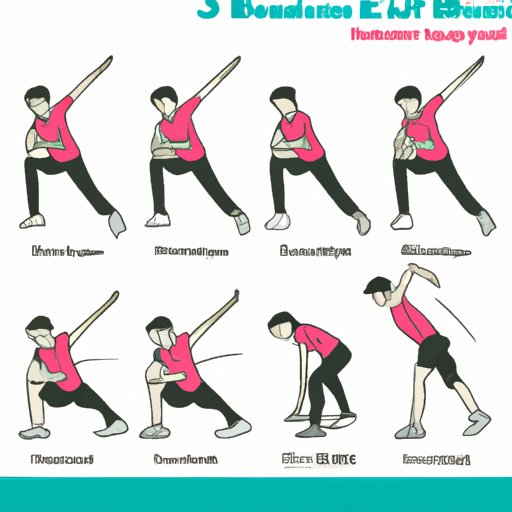Introduction
Exercise is a vital part of staying healthy and living a long life. Regular physical activity has numerous health benefits such as improved cardiovascular health, lower blood pressure, better sleep, and increased energy levels. According to the World Health Organization, adults should get at least 150 minutes of moderate-intensity aerobic activity or 75 minutes of vigorous-intensity aerobic activity per week. For those who are just starting out, it can be challenging to know where to begin.
This article will provide advice on how to exercise, from outlining a beginner’s exercise routine to providing tips on how to stay motivated. By the end of this article, you will have a better understanding of the different types of exercises, their various benefits, and how to properly incorporate them into your lifestyle.

Different Types of Exercises and Their Benefits
When it comes to exercising, there are three main categories: aerobic exercises, strength training exercises, and stretching and flexibility. Each type of exercise helps strengthen different parts of the body and has its own unique set of benefits.
Aerobic Exercises
Also known as “cardio”, aerobic exercises are activities that increase your heart rate and breathing rate. Examples of aerobic exercises include running, walking, cycling, swimming, and dancing. These activities help strengthen your heart and lungs and improve your overall cardiovascular health. According to a study by the American Heart Association, regular aerobic exercise can reduce the risk of heart disease, stroke, type 2 diabetes, and some forms of cancer.
Strength Training Exercises
Strength training exercises, also known as weightlifting or resistance training, involve using weights or other resistance tools to build muscle mass and strength. Examples of strength training exercises include push-ups, squats, lunges, and crunches. Strength training can help improve posture, decrease pain, boost metabolism, and reduce the risk of osteoporosis. A study published in the journal Medicine & Science in Sports & Exercise found that strength training can also reduce the risk of injury and improve physical performance.
Stretching and Flexibility
Stretching and flexibility exercises help improve your range of motion and prevent injuries. Examples of stretching and flexibility exercises include yoga, Pilates, and Tai Chi. These exercises help improve balance, coordination, and posture, as well as reduce stress. According to a study published in the journal Frontiers in Physiology, stretching and flexibility exercises can also improve athletic performance.
Outlining a Beginner’s Exercise Routine
If you’re new to exercise, it’s important to start slowly and gradually build up your intensity. The following tips will help you create an effective and safe exercise routine:
Suggested Exercises for Beginner Level
When creating your workout routine, it’s best to mix up your exercises to keep things interesting. Start with low-impact activities such as walking, jogging, swimming, or biking. As your fitness level improves, you can add more intense activities such as running, HIIT (High Intensity Interval Training), or strength training. It’s also important to include stretching and flexibility exercises to help prevent injuries.
Frequency of Exercising
It’s recommended that you exercise at least 3-4 times a week for 30-60 minutes each time. You can break up the duration into shorter 10-15 minute sessions throughout the day if that works better for you. The key is to find a schedule that works for you and stick to it.
Time Commitment
When planning your exercise routine, factor in the time it takes to prepare for your workout. Make sure you have all the necessary equipment such as comfortable clothes, shoes, water bottle, etc. Also, give yourself enough time to warm up and cool down. Warming up helps your body adjust to the upcoming physical activity while cooling down helps your body transition back to its resting state.
What to Wear and Bring
When exercising, it’s important to wear the right clothes and bring the right items. Wear loose-fitting clothes that are comfortable and breathable. If you’ll be exercising outdoors, make sure to wear sunscreen and a hat. Bring a water bottle and a towel to stay hydrated and wipe away sweat. If you’re going to the gym, bring a lock for your locker and a pair of headphones.

Explaining Proper Form for Popular Exercises
Proper form is essential for any exercise. Without proper form, you won’t be able to reap the full benefits of the exercise and could even put yourself at risk of injury. Here are some tips for perfecting the form of popular exercises:
Squats
Start with your feet shoulder-width apart and your toes pointing slightly outward. Bend your knees and lower your hips as if you were sitting in a chair. Keep your chest up, shoulders back, and abs tight. Push through your heels to return to the starting position.
Push-Ups
Start in a plank position with your hands directly below your shoulders. Lower your body until your chest is just above the ground. Keep your core tight and your body in a straight line. Push through your palms to return to the starting position.
Lunges
Start standing with your feet hip-width apart. Step one foot forward and lower your hips until both knees are bent at 90-degree angles. Make sure your front knee is directly over your ankle and your back knee is close to the ground. Push through your front heel to return to the starting position.
Crunches
Lie flat on your back with your legs bent and your feet flat on the ground. Place your hands behind your head and lift your upper body off the ground. Engage your core and avoid pulling on your neck. Lower your body back to the starting position.
Discussing the Importance of Stretching and Warm-Up Exercises
Warm-up exercises and stretching are essential for any workout routine. They help prepare your body for the upcoming physical activity and reduce the risk of injury. Here are some benefits of warm-up exercises and stretching:
Benefits of Warm-Up Exercises
Warm-up exercises help increase your heart rate and body temperature, which helps your body prepare for physical activity. Examples of warm-up exercises include light jogging, jumping jacks, arm circles, and leg swings. These exercises help loosen up your muscles and joints and improve your flexibility.
Benefits of Stretching
Stretching helps increase flexibility and range of motion. It also helps improve circulation, which helps deliver oxygen and nutrients to your muscles. Examples of stretching exercises include yoga, Pilates, and foam rolling. Stretching after a workout helps reduce muscle soreness and improve recovery time.

Providing Tips on How to Stay Motivated to Exercise
Staying motivated to exercise can be difficult, especially when you’re just starting out. Here are some tips on how to stay motivated:
Setting Goals
Setting goals can help keep you motivated and focused. Make sure your goals are realistic and achievable. Start with short-term goals such as going to the gym 3 times a week or running for 20 minutes. As you reach each goal, set new ones to keep pushing yourself.
Tracking Progress
Tracking your progress can help you stay motivated and see how far you’ve come. You can track your progress by keeping a log of your workouts or taking pictures of yourself before and after. Seeing the results of your hard work can be a great motivator.
Finding a Workout Buddy
Having someone to work out with can be a great way to stay motivated. Having a workout buddy holds you accountable and makes exercising more fun. You can motivate each other and celebrate your successes together.
Mixing Up Your Routine
Doing the same exercises over and over again can become monotonous and lead to boredom. Mixing up your routine keeps things interesting and helps prevent burnout. Try different exercises, switch up your reps and sets, or add new equipment to your routine.
Highlighting the Health Benefits of Regular Exercise
Regular physical activity has numerous health benefits. Here are some of the benefits of exercising regularly:
Improved Cardiovascular Health
Exercising regularly helps strengthen your heart and lungs and improve your overall cardiovascular health. A study published in the journal Circulation found that regular physical activity can reduce the risk of heart attack and stroke by up to 30%.
Lower Blood Pressure
Physical activity helps lower your blood pressure by increasing the production of nitric oxide, a compound that relaxes your blood vessels. According to a study published in the journal Hypertension, regular exercise can reduce systolic blood pressure by 4-9 mmHg and diastolic blood pressure by 3-7 mmHg.
Better Sleep
Exercising regularly can help improve sleep quality and duration. A study published in the journal Sleep Medicine Reviews found that regular physical activity can reduce the time it takes to fall asleep and increase the amount of deep sleep.
Increased Energy Levels
Regular exercise helps increase your energy levels by improving circulation and oxygen delivery to your cells. According to a study published in the journal Psychotherapy and Psychosomatics, regular physical activity can help reduce fatigue and increase energy levels.
Conclusion
Regular physical activity is essential for good physical health. Exercise can help improve cardiovascular health, lower blood pressure, improve sleep, and increase energy levels. This article has provided an overview of different types of exercises, their various benefits, and how to properly incorporate them into your lifestyle. Remember to start slowly, mix up your routine, and find ways to stay motivated. With the right mindset and dedication, you can create a sustainable exercise routine that works for you.
(Note: Is this article not meeting your expectations? Do you have knowledge or insights to share? Unlock new opportunities and expand your reach by joining our authors team. Click Registration to join us and share your expertise with our readers.)
